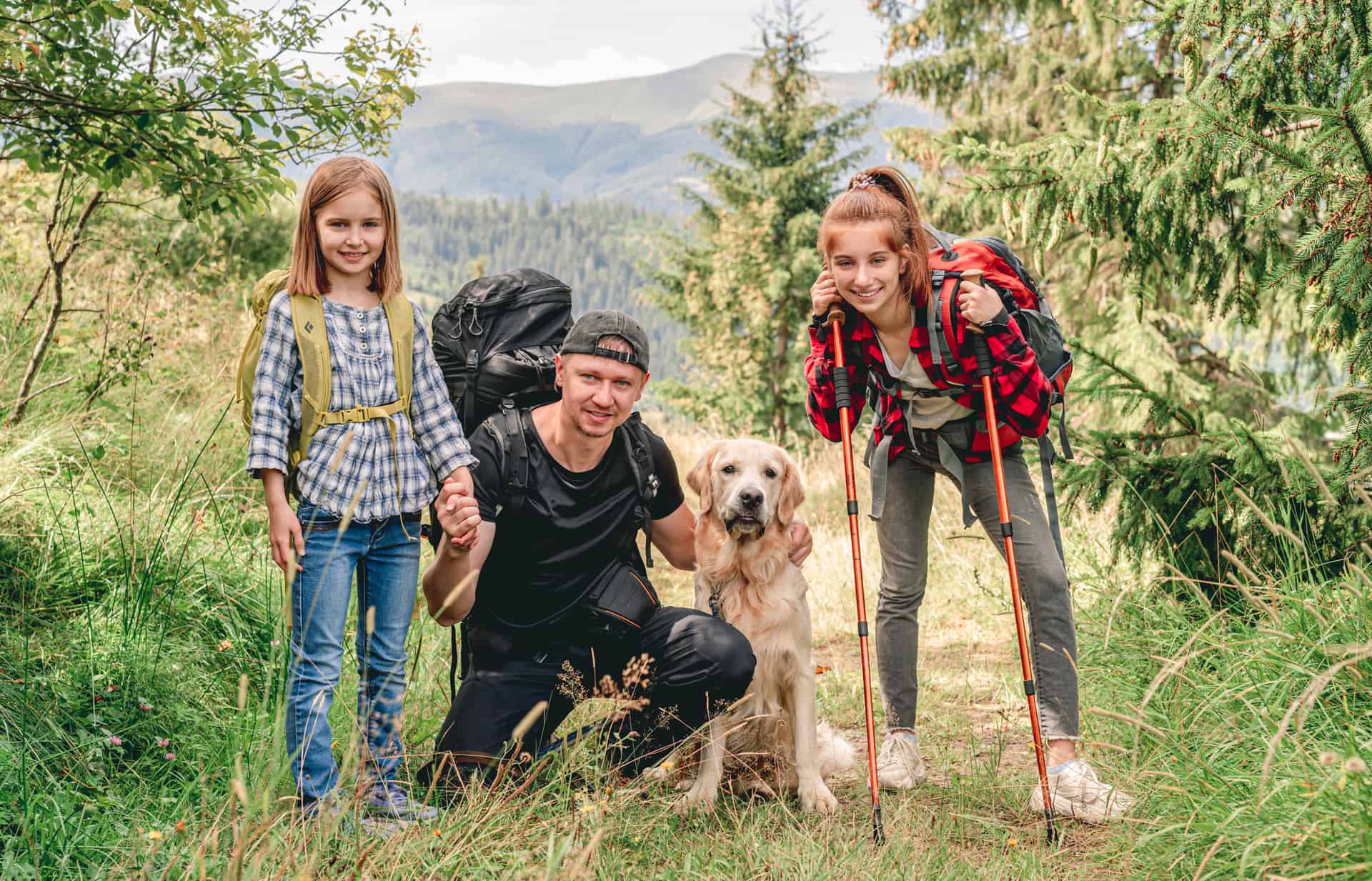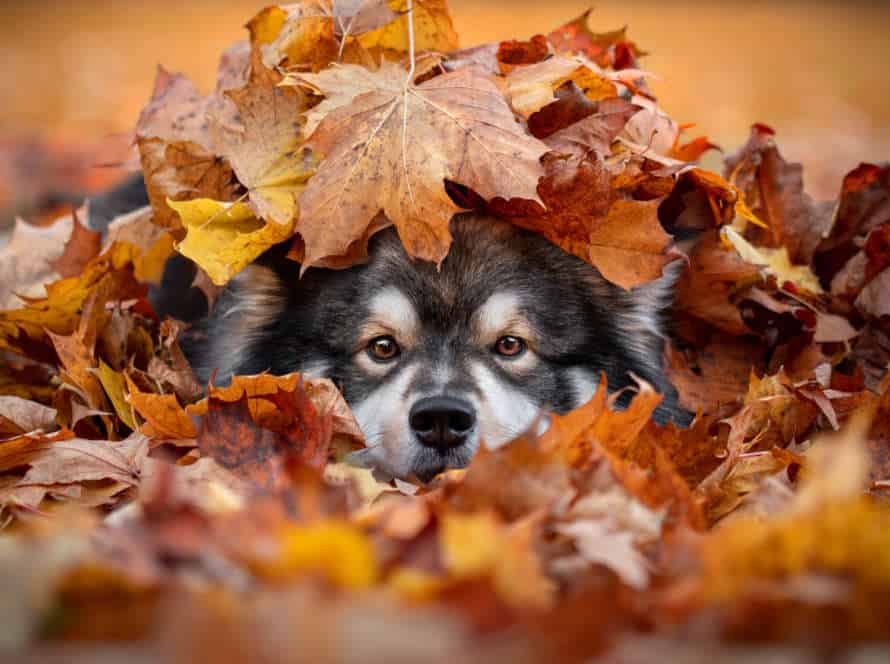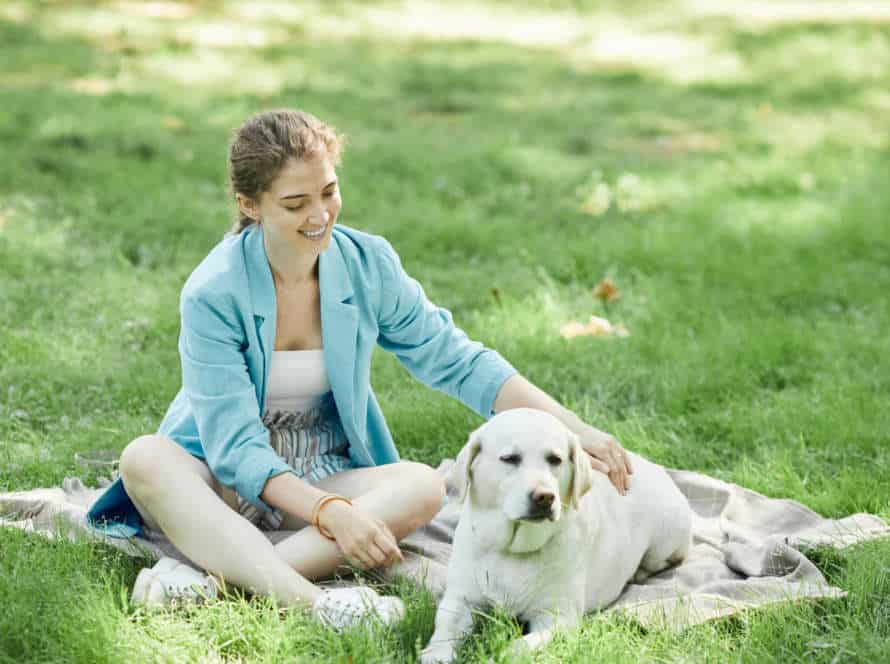Hiking Safety Tips for You and Your Dog
Hiking with your pup can be fun and fulfilling – whether you’re an experienced hiker or a beginner! To ensure safety, here are some tips:
- Carry enough water for both of you. Bring a collapsible bowl too.
- Pack a pet first aid kit with bandages, tweezers, and antiseptic wipes.
- Dress your pup for the weather and terrain. Dog boots may be necessary too.
- Keep your dog on a leash, and have proper identification, like a collar and microchip.
- Check for ticks and other parasites after the hike, and give them a bath if needed.
- Know your pup’s limits and pick a trail to match their fitness level.
Follow these tips and you and your pup can have a safe and delightful hike!
Fun Fact: Hiking with your pup increases both physical activity and emotional bond!
Plan for the Hike
Planning a hike with your pup? As important as planning for yourself! Consider the terrain, temperature and time you’ll be out. Also, be ready for possible obstacles like creeks and wild animals. Being fully prepared ensures a successful, safe outing!
Research the Trail and Check the Weather Forecast
Before going on a hike with your pup, it’s important to plan. Research the trail and check the weather forecast!
For your trail, find out info like the terrain, difficulty, and any potential hazards. This will help you prepare, bring the right gear, and avoid surprises.
Check the forecast too. Knowing the weather will help you dress right and take precautions. For example, if it’s hot, bring water for you and your doggy and take breaks.
By taking these steps, you’ll be better prepared and can have a safe and fun time in nature with your pup!
Inform Someone of Your Hiking Plans
A must-do safety tip when going hiking with your dog: tell someone your plan! Let a friend or family know your route and when you’ll be back. And leave a copy of your plans in the car with your contact info.
Plus, remember to bring:
- Water and snacks for you and your pup.
- Stay on marked trails and look out for dangers.
- Keep your pup on a leash or under voice control.
- A first aid kit, sunscreen, and insect repellent.
Do all this and your hike will be a safe and fun experience for both of you!
Bring the Right Gear
When hiking, it is vital to bring the perfect equipment for you and your pup. Here are some safety tips:
- Buy a strong leash and collar. Make sure your pooch wears one with your contact info.
- Provide enough food and water for both of you. Your dog may need more water than normal, so bring a foldable bowl and lots of H2O.
- Pack a first-aid kit with items such as bandages, tweezers and antiseptic. These can come in handy for any irritations or minor injuries.
- Wear the right shoes and clothing. Have a hat and sunscreen for yourself and keep an eye out for signs of dehydration in your pup.
By taking the right gear, you can stay safe and comfortable on any trail. Pro tip- Find out the trail’s difficulty level before you set off and plan accordingly.
Stay Hydrated and Fuelled
Take your pup hiking! It’s a fantastic way to get outdoors and become closer. But don’t forget – it is essential to stay hydrated and fuelled on the trail.
Here are some tips to make sure both you and your pooch are in top form:
- Bring enough water to keep both you and your pup hydrated on the trail.
- Pack snacks to keep your energy levels up and bring treats for your furry friend as well.
- Remember to take breaks when needed to avoid overexertion or heat exhaustion.
Bring Enough Water for Both You and Your Dog
Hiking with your pup? Make sure you keep them hydrated! Here’s some tips for your next outdoor adventure:
- Pack a water bottle with a built-in dog bowl.
- Bring enough water for the whole trip, plus extra in case of emergencies.
- Pre-hydrate your pup before the hike, and offer water breaks every 30 minutes.
- Look out for signs of dehydration: lethargy, dry mouth, sunken eyes. Provide water and shade if seen.
- Don’t share water bottles – this can spread bacteria and other germs.
Safety first! Keep your pup and yourself hydrated during your hike.
Bring Snacks to Keep You and Your Dog Energized
Hiking with your pup? Bring snacks! Fruits like apples, bananas, and oranges are a great choice. Energy bars and trail mix with nuts and dried fruits are also tasty options. Don’t forget water for both of you. Make sure you have access to clean, fresh sources. Hydration is key for staying safe and healthy. Pack snacks and water in lightweight, easy-to-carry containers like a hydration pack or a collapsible water bottle. Pro tip: Check the trail’s guidelines for bringing dogs. Make sure your pup is up for the hike!
Ensure Your Dog is Ready for the Hike
Before your pup’s hike, it is vital to make sure they are ready. Consider the location, terrain, and length of the hike. Here are some key elements for their comfort and safety.
Before the hike:
- Check their energy level
- Inspect their paws
- Make sure their vaccinations are up-to-date
During the hike:
- Bring plenty of water
- Watch out for any potential dangers
- Take frequent breaks
Consider Your Dog’s Age, Breed, and Health
Before bringing your pup on a hike, it’s important to think about their age, breed, and health.
- Age: Puppies and elderly dogs may not have enough stamina for long hikes, so be sure to talk to your vet before you go.
- Breed: Some breeds are better for hiking than others. Energetic breeds like Aussies, Border Collies, and Huskies are good for the trail, but small breeds like Chihuahuas may struggle.
- Health: If your pup has any pre-existing medical conditions, check with your vet first. Dogs with heart, hip, or joint issues may not be able to handle long walks or rough terrain.
Remember to bring food, water, and first aid supplies for both you and your pup. Monitor your pup for any signs of distress.
Train Your Dog to Stay Close and Come When Called
Train your pup to stay close and come when called to keep them safe on a hike.
Start by teaching basic commands like “stay” and “come” in a controlled environment, like your backyard or a park.
Reward good behaviour as you increase distractions and distance.
Practice in a safe, familiar area with a leash.
Make sure your pup is identified and vaccinated before hitting the trails.
If you meet other hikers or wildlife, recall your pup and give them a treat.
With patience and persistence, your pup will learn to stay close and come when called on hikes.
Pro Tip: Pack extra water and treats for your pup and check their paws for injuries or irritations.
Bring Dog-Specific Gear – Collar, Leash, and Water Bowl
When going on a hike, it is important to bring dog-related items. This ensures safety and comfort for you and your pup. Get a collar that fits snugly and a reliable leash. Also, bring a portable water bowl. Extra items like food, treats, waste bags and first-aid kit are great to have too. Select a hiking trail that is good for dogs and remember to keep your pup on a leash and clean up after them. Pro tip: Train your dog and assess their fitness before heading out!
Keep Your Dog Safe on the Hike
Fetching your pup for a hike? That’s pawsome! But, to keep your dog safe on the trails, follow these tips:
- Plan ahead for safety. Make sure you know what to do before you go.
- Ensure your pup is happy and safe.
- Enjoy nature with your furry friend!
Check for Ticks and Other Pests
Ticks and other pests can be a serious risk to your pup when you go on a hike. Thus, it’s crucial to inspect your dog for ticks, fleas, and other dangerous bugs after every hike. Here’s how to do it right:
- Brush your dog’s fur with a fine-toothed comb, from head to tail. Focus on the neck and ear regions where ticks cluster.
- Look closely at your pup’s paws, nose, and ears for any signs of ticks, fleas, or other pests.
- If you spot a tick, use tweezers, and take it out carefully by pulling it straight out with steady pressure.
- After the hike, give your pup a bath, with tick or flea shampoo, to get rid of any parasites in its coat.
Pro Tip: Prevention is better than cure. Before going on a hike, use a tick-repelling collar, spot-on treatment, or give your dog oral flea and tick medication.
Watch for Harmful Plants
When taking your pup for a hike, careful watch is needed for any dangerous plants. These are some to be aware of:
- Poison Ivy: This plant has an oil that can irritate your dog’s skin. Itching and rashes may occur. So, stay away from the plant and keep your pup from sniffing or touching.
- Foxtails: These grass-like weeds have seed heads that can burrow into your dog’s skin or ears. This can cause infections. Check your pup’s coat after a hike and remove any foxtails.
- Wild Mushrooms: Fungi that can be poisonous if ingested. This can cause vomiting, diarrhea, or neurological problems. Keep your pup away from any mushrooms you see.
If signs of illness appear, get veterinary help immediately. Pro Tip: Carry a first aid kit and know the nearest animal hospital on the hiking route.
Keep Your Dog Safe from Wildlife and Other Dogs
Hiking with your furry pal can be awesome! But, it’s vital to keep them safe from wildlife and other pups. Here are tips for a successful and fun hike:
- Know the area. Research the trail and check for dog attacks or wildlife encounters. Avoid trails that are known for these.
- Leash your pup. Keep them on a leash all the time, to control them in case of an unexpected event.
- Bring Bear Bells. If hiking in an area with bears, consider bringing bells. They make noise and alert wildlife of your presence.
- Carry a First Aid Kit. Pack a first aid kit with items for you and your pup, such as bandages, antiseptic wipes, tweezers.
- Avoid crowded trails. If your pup is uncomfortable around other dogs, pick less busy trails, or avoid peak times.
- Pro Tip: Be mindful of your surroundings and your pup’s behavior, to spot potential danger.
Be Prepared for Emergencies
Hiking with Fido can be a blast – but prepping for potential emergencies is key. Here’s the scoop on how to be ready for anything during your hike!
- Have the right safety measures in place.
- Bring supplies for any unexpected situations.
- And keep your pup close and safe.
Get out there and have a great time!
Pack a First Aid Kit
A well-stocked first aid kit is a must-have for any hike. Especially if you’re trekking with your furry pal! Here’s what you need to add to your kit:
- Antiseptic wipes or spray
- Different sized band-aids
- Gauze pads & medical tape
- Tweezers to remove splinters/ticks
- Instant cold packs
- An EpiPen (if allergic)
- Scissors
- A digital thermometer
- Bug spray
- Ibuprofen/acetaminophen for pain relief
Be sure to store your first aid kit somewhere easily accessible. After every hike, replace any used or expired items. Lastly, educate yourself on first aid techniques and practices – to be truly prepared!
Know How to Treat Common Injuries
Hiking with your pup is a great way to create a bond and experience the outdoors! But, accidents can occur, and it’s important to know how to treat typical injuries when trekking with your dog. Here are some tips to help you be ready for an emergency:
- Bring a first aid kit that includes bandages, wipes with antiseptic, tweezers, and a tick remover.
- Understand the symptoms of heatstroke, hypothermia, and dehydration in your pup, and be aware of how to handle them.
- If there’s a sprain or strain, rest your pup and apply a cold compress to the affected region.
- If your pup gets a cut, clean the wound with an antiseptic and cover with a bandage or gauze.
- Always carry plenty of water and a folding bowl for your pup to drink from.
- Lastly, take a first aid course or get knowledgeable about basics of first aid to be prepared for any situation.
Have an Emergency Plan
If you’re hiking with your pup, you must plan for emergency situations. Preparing in advance could save lives. Here are some tips:
- Learn about the trail: any dangers or difficult terrain?
- Pack a first aid kit & necessary meds for both you & your dog.
- Bring food & water, plus extra in case of emergency.
- Keep your phone charged & bring a portable charger.
- Tell someone where you’re going & when you’ll return.
- Know basic first aid & CPR for your pup.
Remember, being ready is the key to safety. Pro tip: Consider taking a wilderness first aid course.
Leave No Trace
Hit the trails? Remember the Leave No Trace 7 Principles! They help hikers and dogs minimize impacts on nature. Preserve the area and respect the trails. Let’s explore the Leave No Trace Principles. Keep you and pup safe on the trails!
- Plan ahead and prepare.
- Travel and camp on durable surfaces.
- Dispose of waste properly.
- Leave what you find.
- Minimize campfire impact.
- Respect wildlife.
- Be considerate of other visitors.
Follow Leave No Trace Principles
When you and your furry pal explore the trails, it is vital to observe the Leave No Trace principles. For both your safety and that of the environment. Here they are:
- Plan ahead. Know the rules and pack accordingly.
- Travel and camp on hard surfaces. Stick to the designated trails and campsites to protect the soil and plants.
- Dispose of waste correctly. Take out all trash and dog waste. It can pollute water and hurt wildlife.
- Leave what you find. Don’t take home plants, rocks, or other natural objects.
- Keep campfire impact low. Use existing fire rings or a portable stove. Keep fires small to protect the landscape.
- Respect wild animals. Watch them from a distance. Don’t let your pup run after or disturb them.
- Be courteous to other hikers. Yield to them and keep Fido leashed or under control.
By following the Leave No Trace principles you ensure a safe and responsible hike for you and your four-legged friend.
Dispose of Waste Properly
Proper waste disposal is essential for Leave No Trace practices when hiking with your dog. It helps protect the environment and other hikers. Here’s how:
- Dog Waste: Take waste bags with you while hiking. Collect the dog poop and carry it back to a designated bin. Don’t bury it!
- Human Waste: Use designated “cat holes” to bury human feces at least 200 feet away from trails, water sources or campsites. If there are no cat holes, carry a waste bag and take it out with the trash.
- Trash: Take out all trash, including food scraps and cigarette butts. Don’t leave anything on the trail or think it can decompose.
By following these principles, we can keep nature’s beauty intact for future generations.
Respect Wildlife and Natural Features
Respecting wildlife and nature is key to following Leave No Trace principles while going on a hike with your furry pal. Here are some tips to limit your effect on the environment and ensure safety for you and your pet:
- Stay on official trails to protect fragile natural areas and avoid any unexpected meetings with wildlife.
- Keep your dog on a leash to stop them from chasing or hassling animals. Check local regulations and leash laws before you begin your hike.
- Do not feed wildlife as this can lead to dependency and habituation, putting the animals in danger. Feeding your dog somewhere other than approved areas can also disrupt natural ecosystems.
- Respect wildlife habitats and nesting sites. Stay a safe distance from animals and their homes, and do not disturb them.
- Make sure to responsibly dispose of all trash and dog waste. Use biodegradable bags or bury it away from water sources and trails.
By sticking to these tips, you will safeguard natural habitats and make sure you and your dog have a nice, safe hike.
Frequently Asked Questions
1. Q: What are the essential items to bring for hiking with my dog?
A: It is important to bring enough water for both you and your dog, snacks, poop bags, a leash and collar, and a first aid kit.
2. Q: Is it safe to let my dog off-leash while hiking?
A: It depends on the hiking trail and the rules of the area. Make sure to read the signs and follow the leash laws. It’s always best to keep your dog on a leash to prevent them from getting lost or injured.
3. Q: How can I protect my dog from ticks and fleas while hiking?
A: Use a tick and flea prevention product recommended by your vet, check your dog for ticks and fleas regularly during the hike, and stay on established trails to avoid areas with high concentrations of ticks and fleas.
4. Q: What should I do if my dog gets injured while hiking?
A: Carry a first aid kits designed for dogs, learn basic dog first aid, and create an emergency plan in case of any accidents. If the injury is severe, seek veterinary care immediately.
5. Q: Can I bring any dog breed for hiking?
A: It depends on the breed and the type of hiking you plan to do. Some breeds, like brachycephalic breeds (dogs with short faces), may not do well at high altitudes or in hot and humid weather. Talk to your vet before hiking with your dog to ensure they are healthy enough for the activity.
6. Q: What should I do if my dog comes into contact with wildlife while hiking?
A: Keep your dog on a leash at all times and teach them basic commands to prevent them from chasing or interacting with wildlife. If your dog does come into contact with wildlife, give them plenty of space, and avoid approaching any dangerous animals.







